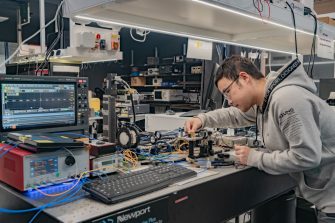
The Telecommunications Group within the School of Electrical Engineering and Telecommunications conducts leading research in four areas: wireless communications, data network, signal processing and photonics.
We recognise the importance of efficient spectrum utilisation in physical wireless communications, the need to manage cybersecurity, quality of service and mobility issues in data networking. Another area of interest is to compress, communicate and appropriate interpret multimedia content to address traffic issues.
Within the telecommunications space, there is growing recognition of the importance of distributed systems which can simultaneously exploit redundancy and diversity. To address this trend, distributed coding techniques have emerged separately in the fields of source coding, channel coding and network coding. Our mission is to innovate solutions and systems to utilise redundancy and diversity in distributed environments to advance distributed multimedia communications.
Our researchers contribute towards CSIRO Data61-Australia's leading digital research network.
Learn more about the telecommunications research capabilities within the UNSW Research Capabilities and Technology Portfolio.
-
The research work of the wireless communications group concentrates on multiple antennas techniques, multiple access, Massive MIMO, OFDM, OTFS, space-time processing, IoT, coding, modulation and equalisation and synchronisation mechanisms.
The major research areas of the group are:
- Multiuser information theory: Error control coding, fundamental limits, etc
- Turbo-like processing and iterative receiver design: Regarded as the latest revolutionary technique, for tough channels (RF and underwater)
- Wireless network coding: Use network coding rather than routing
- Multiple antenna communications: MIMO, Massive MIMO, Space-time processing
- Cognitive radio: Spectrum agile communications, machine-learning for wireless communications
- Dedicated short range communications: For inter-vehicle comms and related applications
- IoT and Satellite Communications: massive access, ultra-reliable low latency communications (uRLLC)
- Millimeter Wave (mmWave) and terahertz (THz) communications
-
The data networks group research work focuses on Internet Traffic Analytics, Cybersecurity of Internet-of-Things, Quality of Service, and Mobile Internet Services.
The major areas of current work are:
- Programmable and Software-Defined Networking: fine-grained visibility and dynamic management of network traffic
- Internet-of-things and sensor networks: smart campus/buildings and wearables
- Cybersecurity and Trust: behavioural modelling of connected devices and network applications
- Telepresence systems: Speaker localisation (signal processing); Network protocols
- Quantum coding for communications: Major new cross disciplinary area
- Quantum communications: Major new cross disciplinary area
-
The photonics group is home to a variety of research projects covering a broad range of photonics and terahertz applications
Amongst others, the group hosts projects targeting the design and fabrication of novel polymer-based segmented cladding fibres, the development of liquid-crystal based transducers for sensing networks, brain/machine interface and laser applications, terahertz communications, imaging, sensing and localisation.
The group has active links with industry partners such as Schneider Electric, Thales Underwater Systems, Silanna, Ampcontrol, Sydney Water, Lastek, Nokia Bell Labs and with numerous academic institutions such as Cambridge University, City University Hong-Kong, Beijing Jiatong University, University of Melbourne, Macquarie University, Sydney University, University of Adelaide, UniSA, and RMIT.
Current areas of research include:
- Specialty silica and polymer optical fibres
- Photonic fibre devices: Lasers, gratings, amplifiers
- Fibre based sensors: structural health monitoring, distributed voltage/current sensors
- New photonic materials: Including organic materials for vision, display, tactile sensors
- Liquid crystal transducers for low-power, intrinsically safe sensing applications
- Optrodes technologies for brain/machine interface
- Integrated terahertz (THz) components and devices for next generation of wireless communication (6G and beyond)
- Terahertz communication, imaging, sensing and localisation




